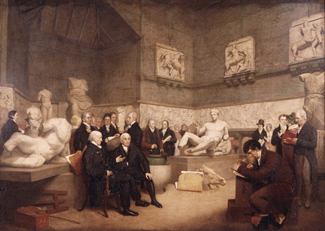6 Easel painting
Because of the way they have come down to us in fragmentary form, and also partly because of the way the paintings are reproduced in books and on computer screens, it is easy for us to regard the Nebamun paintings in the way we most commonly encounter paintings in our own culture, that is, as ‘easel paintings’.
‘Easel paintings’ are pictures painted on a canvas, or a piece of wood, usually rectangular, and supported on an easel in front of which the individual artist stands. In the post-Renaissance western painting tradition, most easel paintings have a dominant scene, usually a figure or a group of figures on which we focus our attention.
In the fifteenth century, in Renaissance Italy, this was one of the things that made a picture modern, which differentiated it from the medieval chronicle, or its visual equivalent, (or indeed, the Eastern ‘tale’) where one incident followed another, and another, and another without any special emphasis or focus. The idea of such a focus, a principal event on which to concentrate, that the picture was in some absolute sense ‘about’, rapidly became the normal sense of what a work of art was in the western tradition.
Now examine the painting by Archibald Archer (Figure 10) and then answer the questions below.

Can you describe the main components of the picture? What kinds of things are represented?
The picture shows an interior scene of a large room. A group of men are sitting and standing amongst a number of sculptures.
Who are the people? What are they doing? What is it about?
To a contemporary viewer the picture would show one of the most important ‘moments’ in the history of English art.
It shows a group of artists and scholars copying and discussing the recently acquired ‘Elgin marbles’ – sculptures form the Parthenon in Athens. The revelation of these ancient works from Greece, the fountain head of the Western canon, had an important effect on nineteenth-century British art.
The people who removed the paintings from the walls of Nebamun’s tomb-chapel in the early nineteenth century seem perhaps to have regarded them in this way: as if they were ‘easel’ paintings. They cut out what they felt to be interesting or vivid pictures in their own right, or which they felt would be attractive to European taste, and the resulting fragments were subsequently mounted for display in frames.
